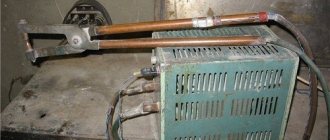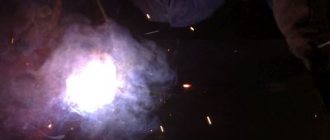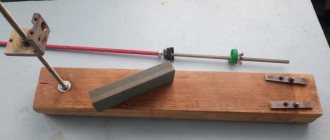The efficiency of high-temperature processing of metals is increased by welding mixtures of shielding gases used to create a protective cloud over the molten metal. It is much more profitable to use special gas mixtures for welding than pure gases. Several standardized compositions have been developed for use in carbon, low- and high-alloy steels and non-ferrous metals.
It has been experimentally proven that mixtures improve the quality of the melt, reduce the amount of metal spatter, and increase the productivity of the welder. Welding seams become plastic, and arc combustion is noticeably stabilized. The influence of harmful factors is reduced by reducing smoke, and working conditions are improved.
Properties and purpose
The welding mixture, which creates a protective cloud over the melt pool, can have both positive and negative effects on the welding process. Noble gases behave differently:
- Argon, due to air ionization, supports the arc and ensures high-quality metal transfer. When working with thick-walled workpieces and rolled metals with high thermal conductivity, argon, which is characterized by low energy output, is ineffective.
- Helium is preferable from this point of view, but has less effect on the stability of the arc and does not improve the transfer of metal additive to the surface of the workpiece.
- Carbon dioxide provides good protection due to its high density and reduces splashing of liquid metal.
Each individual gas has unique properties; when combined, they neutralize the negative effects of individual components and enhance the positive effects. The compositions were selected by trial and error in order to improve the quality of seams and welding speed.
In the mixture, shielding gases protect the melt pool much more effectively and reduce the likelihood of defects forming.
The complexity of orbital welding and a ready-made solution to simplify the technology
Orbital welding is used to join pipes and cylindrical containers . They require high-quality double-sided welding, but full access to the underside of the seam is difficult.
In this case, if the diameter of the workpieces is small, they are rotated in front of the welding torch; if the diameter is large or it is impossible to rotate, special equipment is put on the workpieces, along which the welding machine moves, like a planet in orbit. This technology often uses preheating of workpieces.
Orbital welding is typically carried out in a pure argon environment . If there are special requirements for the connection according to technical conditions, such as:
- welding speed,
- penetration depth,
- configuration of the wrong side of the seam.
Helium or hydrogen is added to argon. For particularly difficult welding cases, mixtures of several components are created, each of which gives its own effect.
Gas mixtures
For welding, 4 gaseous colorless substances are used, displacing them from the working area:
- hydrogen, which promotes embrittlement of metals;
- nitrogen, which forms solid slag compounds;
- oxygen, which actively oxidizes metals.
The displacement of gas-air components occurs due to the high density of protective gases; they form a sedentary cloud. All welding gas mixtures have a specific gravity greater than that of air. The concentration of components was selected experimentally, and the influence of gases on the welding mode was taken into account. Argon-based mixtures significantly expand welding capabilities and increase the efficiency of welders. Minimize the risk of defects in welding seams.
Argon and carbon dioxide
For welding non-ferrous metals, profiles and rolled high-alloy steels, a welding mixture of argon and carbon dioxide is used. Argon reduces the activity of carbon dioxide, and CO2 increases the heat transfer of argon. Welding carbon and low-alloy steels in a protective Ar+CO2 cloud is much more efficient than in each individual gas. With a carbon dioxide concentration of within 20%, thick-walled metal structures are boiled even when the surface is heavily contaminated.
Argon and oxygen
The composition is used for welding low-alloy and nickel-alloyed steels. With a low concentration of oxygen, it is possible to avoid porosity of the seams; argon prevents the formation of oxides. The Ar+O2 combination is used with various types of welding wire, expanding the capabilities of the welding process by increasing arc energy and stable combustion. The metal cooks faster. Smooth seam beads are formed with uniform heating of the filler rod. The strength of the connection increases due to the expansion of the diffusion layer.
Argon and helium
Inert gases are combined in different proportions. The most common compositions are 7:3 and 1:1. The Ar+He composition is used when working with various metals:
- cast iron of various densities;
- with low-alloy and alloy steels with high nickel and chromium content;
- non-ferrous alloys based on copper, aluminum;
- refractory workpieces.
Which is better: welding mixture or carbon dioxide?
Experts decide on their own what is best to cook, taking into account the strength of the joints and the cost of consumables. To isolate the melt formed during the welding process, you can use inert gases argon and helium, carbon dioxide or a welding mixture. With the introduction of inert gases that do not interact with the melt into active ones, the ability of carbon to dissolve in the liquid metal decreases. CO2 is an active gas; when used in its pure form, it saturates steel and non-ferrous metals.
Advantages of using a gas mixture:
- stream transfer of electrode surfacing is facilitated;
- the seams are more flexible;
- the risk of porosity formation is reduced;
- the process of metal melting is accelerated;
- the strength of connections increases;
- less smoke, released substances are retained in the melt zone;
- when the filler wire is fed unevenly, the rhythm of the work is maintained;
- Due to the minimization of spatter, the consumption of electrodes and wire is reduced.
Advantages of welding in a carbon dioxide atmosphere:
- low cost;
- the ability to cook in any spatial position;
- good welding of joints.
Welding productivity when using special mixtures that protect the melt pool from oxidation increases by 50%, while energy consumption does not increase.
Aluminum - revealing the secrets of the method
Widely used in the aerospace and instrument-making industries, aluminum has an unpleasant property for welding: the surface of the low-melting (660°C) metal is always covered with a refractory (more than 2200°C) oxide layer, which prevents parts from being welded properly.
After removing this layer by mechanical or chemical methods, it spontaneously recovers, since aluminum is readily oxidized by the oxygen contained in the air around us. The process accelerates many times when aluminum is heated to its melting point.
Therefore, when welding aluminum parts, it is necessary to reliably protect the working area from contact with air.
Argon is most widely used as a welding mixture for semi-automatic welding . Mixtures with helium are also used for semi-automatic welding. It protects the melt from the negative effects of oxygen, nitrogen and water vapor. Welding is carried out using TIG or MIG technology, using aluminum wire or rod as a filler material.
Selection of welding mixture for semi-automatic machine
Filler wire is produced without a protective coating; semi-automatic devices provide a supply of protective gases. They are mixed according to calculations to create the required combustion temperature, at which the metal blanks and wire do not melt too quickly. With a rational selection of the gas mixture for semi-automatic welding, the process of forming seams is simplified.
Gas mixture selection table for various alloys:
| Carbon structural steels (sheets, narrow sections) | ||||||||
| Wire size(mm) | Joint size (mm) | Current (A) affects welding speed | Name of the mixture according to GOST and international standard | Component composition of the mixture | ||||
| Ar | CO2 | O2 | He | |||||
| 0,8 | 1 | from 45 to 65 | K-3.1 (Argoshield 5 marking possible) | 92% | 6% | 2% | – | |
| 1,6 | from 70 to 80 | |||||||
| 1 | 3 | from 120 to 160 | K-3.2 (Argoshield TC marking possible) | 86% | 12% | 2% | – | |
| 6 | from 140 to 160 | |||||||
| 1,2 | 6 10 | from 250 to 270 from 140 to 160 | ||||||
| 1,2 | 10 | from 270 to 310 from 140 to 160 | K-2 (possibly labeled Pureshield P31) Universal mixture | 82% | 18% | – | – | |
| 1,2 | 10 | from 290 to 330 | K-3.3 marking possible (Argoshield 20) | 78% | 20% | 2% | – | |
| Alloy steels (heat-resistant, heat-resistant, stainless, acid-resistant) | ||||||||
| 0,8 | 1.6 | from 70 to 855 | NP-1 (possible Helishield HI marking) | 13,5% | 1,5% | – | 85% | |
| 1,0 | 3 6 | from 100 to 125 from 120 to 150 | NP-2 (possible Helishield H7 marking) | 43% | 2% | – | 55% | |
| 1,2 | 6 10 | from 220 to 250 from 120 to 150 | ||||||
| 1,2 | 10 | from 120 to 150 from 260 to 280 from 270 to 310 | NP-3 (possibly marked Helishield H101) | 60% | 2% | – | 38,0% | |
| Aluminum alloys | ||||||||
| 1 | 1,6 | from 70 to 100 | NP-1 (also designated H1 and the inscription Helishield-Н1) | 13,5% | 1.5% | – | 85% | |
| 1.2 | 3 6 | from 105 to 120 from 120 to 140 | – | |||||
| 1,2 | 6 | from 160 to 200 | NP-2 (also designated H7 and the inscription Helishield-H7) | 43% | 2% | – | 55% | |
| 10 | from 120 to 140 | |||||||
| 1,6 | ||||||||
| 1,2-1,6 | from 130 to 200 | |||||||
| 1,5-2,4 | from 300 to 500 | NP-3 (possible markings H101 and Helishield-H101) | 60% | 2% | – | 38% | ||
When using a tungsten electrode and a wire additive, compositions of two inert gases are used:
- НН-1 (full name Helishield-Н3), in this mixture the concentration of helium is within 30%, argon no more than 70%. the gas mixture provides more efficient heating, the metal melting rate increases, and a smooth surface of the seam is formed.
- NN-2 (international marking Helishield-H5) is two inert gases mixed in equal proportions: argon and helium. The universal mixture is used to join black and non-ferrous workpieces of almost any thickness.
The component and quantitative composition affects almost all parameters and modes of metal welding.
Application of mixtures
Oxygen-free mixtures are chosen for high-speed penetration and welding of non-ferrous metals. They produce excellent clean welds with a smooth profile, little surface oxidation, provide low levels of reinforcement and provide high penetration rates. They provide stability to the electric arc when joining materials thicker than 9 mm, and reduce the likelihood of seam defects.
When feeding the gas mixture semi-automatically, the wire feed speed is reduced and the torch heats up faster. We have to adjust the operating mode and select massive heads. To work with mixtures efficiently, professional skills are required.
When choosing ready-made welding gas mixtures with oxygen, the characteristics of the compositions are taken into account. K-2 is considered ideal for ferrous and low-alloy steels. Others were developed for metal of various thicknesses, deep penetration and welding of thin-walled sheets and profiles without deformation. Oxygen-containing compounds are used for short and long seams, restoration surfacing of worn parts. Can be used everywhere: for automatic robots, manual, semi-automatic welding in all spatial positions. Special compositions are selected for profiled rolled steel and for surfacing.
Working with welding mixtures requires professional skills
When manual welding, it is important to maintain the distance from the workpiece to the nozzle. It is necessary to constantly maintain a distance within 15–20 mm from the joint to prevent lack of penetration. The burner is placed at a right angle. It should be taken into account that oxygen mixtures increase the fluidity of the molten metal; problems are possible when working in a ceiling and vertical position.
Self-mixing of gases
Theoretically, the mixture can be prepared directly at the workplace; at the welding areas there are special posts with the installation of rotameters - devices that control the consumption of components per unit of time from each cylinder. Based on the indicators of the rotameters, the composition of the gas mixture supplied to the welders’ workstations is adjusted using gearboxes.
When working with several cylinders at the same time, the composition of the welding mixture will not be ideal. When making gas mixtures yourself, it is impossible to achieve the exact percentage of components down to tenths. The consumption of gases and, accordingly, additives will certainly increase.
Shielding welding gas is the optimal mixture used in the heat treatment of metals. Ready-made formulations are ordered from specialized suppliers or directly from manufacturing plants.
Safety - an ecological view of electric arc technology
In order to avoid causing harm to the health of workers and the environment during welding work, the following rules must be followed:
- the workplace must be equipped with supply and exhaust ventilation,
- the air entering the hood must be cleaned by filtering units to the purity levels established by environmental standards,
- filter units must be configured specifically for the gas that is currently used,
- gas equipment must be in good working order and verified in order to prevent excess gas consumption and the release of excess into the atmosphere,
- Screens should be installed around the work area to prevent the spread of harmful ultraviolet radiation,
- The welder must use personal protective equipment: a welding mask with an adaptive light filter, split-leaf gloves, thick clothing and shoes that cover the entire body, a respirator or personal breathing apparatus with self-contained air supply.
Quality control of the welding mixture allows us to ensure safe working conditions for workers and the environment . Each employee must have their own role in ensuring industrial and environmental safety.











